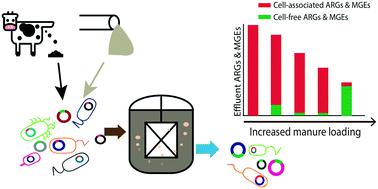当前位置:
X-MOL 学术
›
Environ. Sci.: Water Res. Technol.
›
论文详情
Our official English website, www.x-mol.net, welcomes your
feedback! (Note: you will need to create a separate account there.)
Livestock manure improved antibiotic resistance gene removal during co-treatment of domestic wastewater in an anaerobic membrane bioreactor
Environmental Science: Water Research & Technology ( IF 3.5 ) Pub Date : 2020-08-03 , DOI: 10.1039/d0ew00387e Esther Ge Lou 1, 2, 3, 4 , Moustapha Harb 1, 5, 6, 7 , Adam L. Smith 8, 9, 10, 11 , Lauren B. Stadler 1, 2, 3, 4
Environmental Science: Water Research & Technology ( IF 3.5 ) Pub Date : 2020-08-03 , DOI: 10.1039/d0ew00387e Esther Ge Lou 1, 2, 3, 4 , Moustapha Harb 1, 5, 6, 7 , Adam L. Smith 8, 9, 10, 11 , Lauren B. Stadler 1, 2, 3, 4
Affiliation

|
Anaerobic membrane bioreactors (AnMBRs) can manage complex combined waste streams, recover energy, and produce nutrient-rich effluents for irrigation. To advance AnMBRs for water reuse, the removal of antibiotic resistance genes (ARGs) during co-treatment of waste streams requires further attention. Here, an AnMBR was fed domestic wastewater with increasing amounts of cattle manure. The removal of target genes including nine ARGs and two mobile genetic elements (MGEs) was assessed. Manure addition was found to significantly improve the removal of target genes, with a removal efficiency of 99.95% during the stage with the greatest addition of manure. Further, the effluent contained more cell-free ARGs (cfARGs) than cell-associated ARGs (caARGs) when manure loading was greatest. This study is the first to evaluate ARG and MGE removal during co-treatment of domestic wastewater and livestock manure using AnMBRs, and also the first to differentially characterize the cfARGs/caARGs in an AnMBR effluent treating complex waste streams.
中文翻译:

在厌氧膜生物反应器中共同处理生活污水期间,畜禽粪便改善了抗生素抗性基因的去除
厌氧膜生物反应器(AnMBR)可以管理复杂的合并废物流,回收能量,并产生富含营养的废水进行灌溉。为了促进AnMBRs用于水的再利用,在废物协同处理过程中去除抗生素抗性基因(ARGs)需要进一步关注。在这里,向AnMBR提供的生活污水中添加了越来越多的牛粪。评估了包括9个ARG和2个移动遗传元件(MGE)的靶基因的去除。发现添加粪肥可以显着改善目标基因的去除,在最大添加粪肥的阶段,去除效率为99.95%。此外,当粪便负荷最大时,废水中的无细胞ARGs(cfARGs)比与细胞相关的ARGs(caARGs)多。
更新日期:2020-10-02
中文翻译:

在厌氧膜生物反应器中共同处理生活污水期间,畜禽粪便改善了抗生素抗性基因的去除
厌氧膜生物反应器(AnMBR)可以管理复杂的合并废物流,回收能量,并产生富含营养的废水进行灌溉。为了促进AnMBRs用于水的再利用,在废物协同处理过程中去除抗生素抗性基因(ARGs)需要进一步关注。在这里,向AnMBR提供的生活污水中添加了越来越多的牛粪。评估了包括9个ARG和2个移动遗传元件(MGE)的靶基因的去除。发现添加粪肥可以显着改善目标基因的去除,在最大添加粪肥的阶段,去除效率为99.95%。此外,当粪便负荷最大时,废水中的无细胞ARGs(cfARGs)比与细胞相关的ARGs(caARGs)多。











































 京公网安备 11010802027423号
京公网安备 11010802027423号